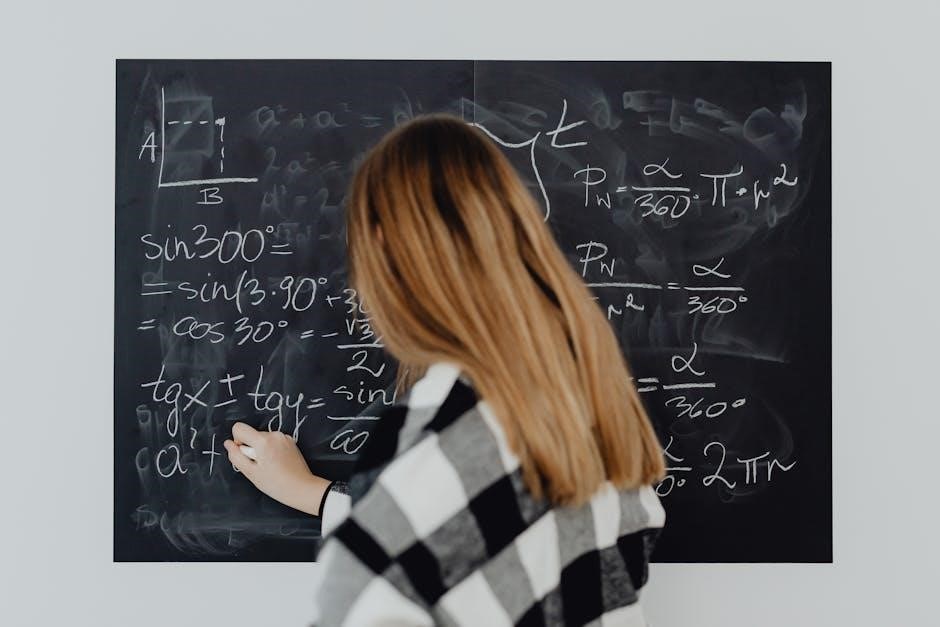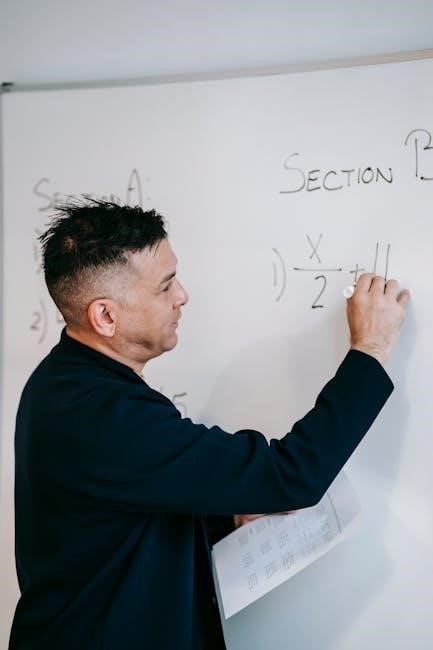
Two-step equations involve solving for a variable using two operations, such as multiplication and addition. They are essential for modeling real-world problems, like budgeting or cooking, and help build foundational algebra skills. Mastering these equations enhances problem-solving abilities and prepares students for more complex mathematical concepts. They are widely used in everyday situations, making them a crucial part of basic algebra education.
What Are Two-Step Equations?
Two-step equations are algebraic expressions that require two separate operations to solve for the variable. These equations typically involve both multiplication/division and addition/subtraction. For example, in the equation (3x + 5 = 20), the first step is subtracting 5 from both sides, and the second step is dividing by 3. These equations are fundamental in algebra as they build upon one-step equations, introducing an additional layer of complexity. They often appear in word problems, making them essential for real-world applications like calculating distances, budgeting, or mixing ingredients. Understanding two-step equations enhances problem-solving skills and prepares students for more advanced mathematical concepts. They are a crucial part of algebraic learning, teaching students to break down problems into manageable steps.
Importance of Solving Two-Step Equations
Solving two-step equations is crucial for developing algebraic reasoning and problem-solving skills. These equations model real-world scenarios, such as calculating distances, budgeting, or mixing ingredients, making them highly applicable in daily life. Mastering two-step equations builds a strong foundation for more complex mathematical concepts, like quadratic equations and word problems. They also enhance logical thinking and the ability to break down problems into manageable steps. In educational settings, these equations help students transition from basic arithmetic to algebraic thinking, preparing them for higher-level math. The ability to solve two-step equations is essential for STEM careers and everyday decision-making, emphasizing their practical importance.

Understanding Word Problems
Word problems present real-life scenarios translated into mathematical language, requiring students to interpret and convert words into equations. They bridge language and math, enhancing analytical thinking skills.
Identifying Key Information in Word Problems
Identifying key information is crucial for solving word problems. Look for numbers, operations, and relationships. Highlight or underline important details to focus on what’s needed. Ask yourself, “What are we trying to find?” and “What information is given?”
Translating Words into Mathematical Expressions
Translating words into math expressions is a vital skill for solving equations. Start by identifying key words like “plus,” “times,” or “more than,” which indicate operations. For example, “Adams Bikes rents bikes for $19 plus $8 per hour” translates to 19 + 8x. Define variables for unknowns, such as letting x represent the number of hours. Use equations to model relationships, like 19 + 8x = 67 for Nicole’s bike rental. Ensure the equation aligns with the problem’s context. Practice worksheets, like those from Kuta Software, provide examples to refine this skill. Accurate translation is the foundation for solving two-step equations effectively and ensuring solutions are meaningful.

Setting Up the Equation
Setting up the equation involves defining variables and translating words into math expressions. Identify unknowns, assign variables, and create equations based on the problem’s context. This step ensures clarity and accuracy in solving two-step equations, helping students model real-world scenarios effectively.

Defining Variables
Defining variables is the first step in setting up an equation. A variable represents an unknown quantity, often denoted by a letter like x or y. When solving word problems, it is crucial to clearly define what the variable stands for to ensure the equation accurately models the situation. For example, in a problem where Nicole paid $67 to rent a bike with a base fee of $19 and $8 per hour, the variable could represent the number of hours she rented the bike. Properly defining variables helps students organize their thoughts and approach the problem systematically. This clarity is essential for accurate solutions in two-step equations.
Writing the Equation Based on the Problem
Writing the equation involves translating the word problem into a mathematical expression. Identify the unknown quantity and represent it with a variable. For example, if Nicole paid $67 to rent a bike with a base fee of $19 and $8 per hour, the equation would be 19 + 8x = 67, where x is the number of hours. Ensure the equation accurately reflects the relationships described in the problem. This step requires careful reading and understanding of the scenario to avoid errors. Once the equation is correctly written, it can be solved using inverse operations to find the value of the variable.

Solving the Equation
To solve two-step equations, first identify the operations affecting the variable. Perform inverse operations step-by-step, ensuring the equation remains balanced. For example, in 3x + 5 = 23, subtract 5 from both sides to get 3x = 18, then divide by 3 to find x = 6. Always check solutions by substitution to verify accuracy and ensure the equation holds true.
Using Inverse Operations

Inverse operations are essential for isolating the variable in two-step equations. Start by identifying the operations applied to the variable. For example, in the equation (3x + 5 = 23), first subtract 5 from both sides to undo the addition, resulting in (3x = 18). Next, divide both sides by 3 to solve for (x), yielding (x = 6). Always apply the inverse operations in the reverse order of the operations performed. This systematic approach ensures the equation remains balanced and leads to the correct solution. Practicing with various problems helps build proficiency in applying inverse operations effectively to solve two-step equations accurately. Regular practice strengthens algebraic manipulation skills and problem-solving confidence.
Checking the Solution by Substitution
Checking the solution by substitution is a critical step to ensure the answer is correct. After solving the equation, substitute the value back into the original equation to verify equality. For example, if the equation is 2x + 3 = 11 and the solution is x = 4, replace x with 4 to check: 2(4) + 3 = 11, which simplifies to 8 + 3 = 11, confirming the solution is correct. This method ensures accuracy and helps identify any calculation errors. Substitution builds confidence in the solution and reinforces understanding of equation balancing. Always verify solutions this way to maintain reliability in problem-solving.

Real-World Applications
Two-step equations are essential in real-world scenarios like budgeting, cooking, and work hours. They help solve problems involving total costs, ingredient quantities, and time management efficiently and accurately.
Examples of Two-Step Equations in Everyday Life
Two-step equations are frequently encountered in daily life, making them practical tools for problem-solving. For instance, calculating the cost of renting a bike, where a fixed rental fee is added to an hourly rate, involves setting up and solving a two-step equation. Similarly, budgeting for groceries, where a discount is applied after adding items, requires this skill. Another example is determining how long it takes to save a certain amount with a monthly contribution, which involves setting up an equation and solving it in two steps. These scenarios highlight how two-step equations help manage money, time, and resources efficiently in real-world situations, emphasizing their importance in developing strong mathematical literacy.

Common Mistakes and Tips
Common mistakes include misapplying inverse operations and miscalculating during translation. Tips: read problems carefully, define variables clearly, and check solutions by substitution to ensure accuracy.
Avoiding Errors in Two-Step Equations
Common errors in two-step equations include misapplying inverse operations and miscalculating during translation. To avoid these, carefully read the problem, identify operations, and define variables clearly. Always check solutions by substituting them back into the original equation to ensure accuracy. Pay attention to the order of operations and avoid skipping steps, as this can lead to incorrect results. Practicing regularly and reviewing mistakes helps build confidence and improves problem-solving skills. Using worksheets and online resources can also provide structured practice and immediate feedback, helping to identify and correct common errors effectively.

Practice Worksheet
Enhance your skills with two-step equation word problem worksheets; Solve real-world scenarios, check answers, and build confidence in algebraic problem-solving with step-by-step guidance.
Sample Problems with Answers
Problem: Adams Bikes rents bikes for $19 plus $8 per hour; Nicole paid $67. How many hours did she rent the bike?
Solution:
౼ Let ( h ) = number of hours.
౼ Equation: ( 19 + 8h = 67 )
─ Subtract 19: ( 8h = 48 )
౼ Divide by 8: ( h = 6 )
Answer: Nicole rented the bike for 6 hours.
Problem: Melanie saves $20 every month. How many months will it take her to save $140?
Solution:
─ Let ( m ) = number of months.
─ Equation: ( 20m = 140 )
─ Divide by 20: ( m = 7 )
Answer: Melanie will save $140 in 7 months.
Problem: A book costs $15. Shipping is $5 plus $2 per book. How much will 10 books cost in total?
Solution:
౼ Let ( b ) = number of books.
─ Equation: ( 5 + 2b = 25 )
౼ Subtract 5: ( 2b = 20 )
─ Divide by 2: ( b = 10 )
Answer: The total cost for 10 books is $25.
These problems illustrate how to set up and solve two-step equations based on real-world scenarios.
Mastering two-step equations is a fundamental skill in algebra, essential for solving a variety of real-world problems. By defining variables, setting up equations, and using inverse operations, students can confidently tackle challenges in budgeting, cooking, and more. Regular practice with worksheets and word problems enhances problem-solving abilities and prepares learners for advanced mathematical concepts. Encourage continuous practice to refine skills and apply these equations to everyday situations effectively.